Breathwork techniques can effectively reduce anxiety and promote emotional release. These practices include diaphragmatic breathing, box breathing, and alternate nostril breathing. They enhance oxygen flow, lower stress hormones, and stabilize the nervous system. Incorporating breathwork into daily routines can empower individuals to manage anxiety and improve emotional well-being.
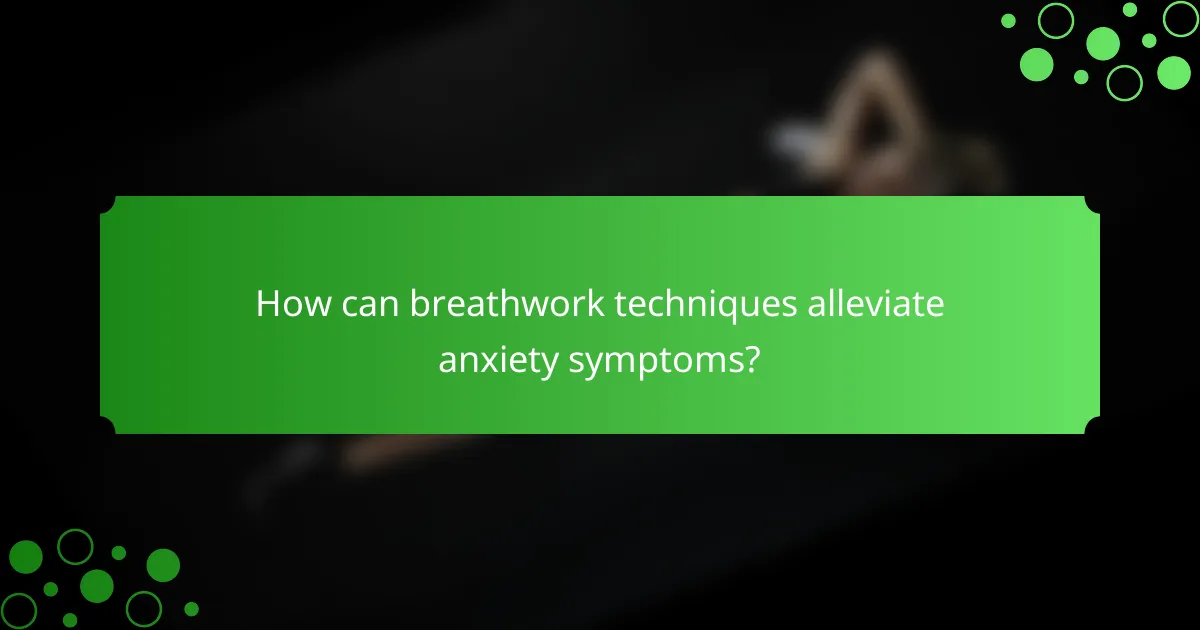
How can breathwork techniques alleviate anxiety symptoms?
Breathwork techniques can significantly alleviate anxiety symptoms by promoting relaxation and emotional release. These practices enhance oxygen flow, reduce stress hormones, and activate the parasympathetic nervous system.
Specific techniques like diaphragmatic breathing and box breathing focus on controlling breath patterns, which can lower heart rates and foster a sense of calm. Studies show that regular breathwork can lead to a 30% reduction in anxiety levels over time.
Additionally, breathwork can help individuals process emotions, facilitating a deeper connection to their mental state. This emotional release can be particularly beneficial for those struggling with unresolved feelings tied to anxiety.
Incorporating breathwork into daily routines can empower individuals to manage their anxiety more effectively, offering a natural and accessible tool for emotional well-being.
What physiological changes occur during breathwork for anxiety relief?
Breathwork techniques induce physiological changes that help alleviate anxiety. These changes include decreased heart rate, reduced muscle tension, and enhanced oxygenation. As a result, the body shifts from a stress response to a state of relaxation. Breathwork also stimulates the parasympathetic nervous system, promoting emotional release and mental clarity. Regular practice can lead to long-term benefits, such as improved emotional regulation and resilience against stress.
Which breathwork methods are most effective for anxiety reduction?
Several breathwork methods effectively reduce anxiety. Techniques such as diaphragmatic breathing, box breathing, and alternate nostril breathing have shown significant benefits. Diaphragmatic breathing engages the diaphragm, promoting relaxation and reducing stress levels. Box breathing involves inhaling, holding, exhaling, and pausing for equal counts, enhancing focus and calming the mind. Alternate nostril breathing balances the body’s energy and calms the nervous system, making it a unique approach for anxiety relief. Each method can be practiced in short sessions, providing immediate emotional release and long-term anxiety management.
How does the duration of breathwork sessions impact anxiety levels?
Longer breathwork sessions typically lead to greater reductions in anxiety levels. Studies indicate that sessions lasting 30 minutes or more can significantly lower stress and anxiety, enhancing emotional release. For instance, a 60-minute session may provide deeper relaxation and mindfulness compared to a 15-minute practice. As a result, duration plays a crucial role in optimizing the benefits of breathwork for anxiety relief.
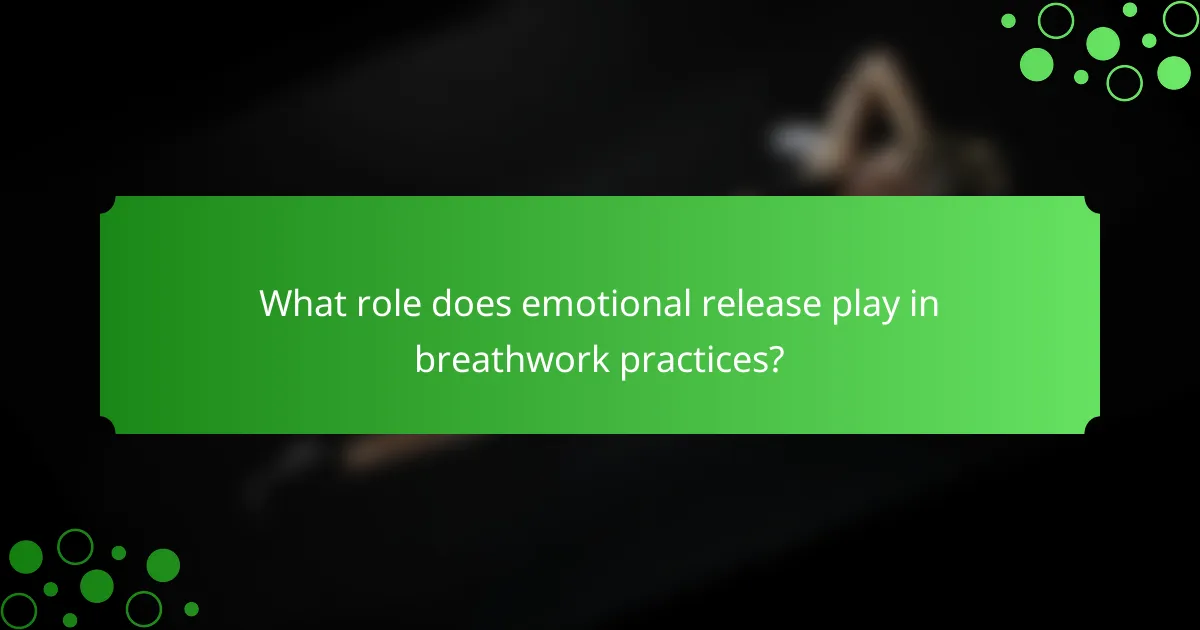
What role does emotional release play in breathwork practices?
Emotional release is crucial in breathwork practices as it facilitates the processing of feelings and reduces anxiety. Breathwork techniques help individuals access repressed emotions, promoting healing and mental clarity. Practitioners often experience a cathartic release, leading to improved emotional regulation and resilience. This transformative aspect of breathwork enhances overall well-being, making it a valuable tool for emotional health.
How do different breathwork techniques facilitate emotional release?
Breathwork techniques facilitate emotional release by promoting relaxation and enhancing self-awareness. Techniques like diaphragmatic breathing reduce anxiety by activating the parasympathetic nervous system. Transformational breathwork encourages deep emotional processing, allowing individuals to confront and release pent-up feelings. Holotropic breathwork can lead to profound experiences, often resulting in significant emotional breakthroughs. These practices collectively support mental clarity and emotional resilience.
What are the psychological benefits of combining breathwork with emotional release?
Combining breathwork with emotional release offers significant psychological benefits, including reduced anxiety and enhanced emotional regulation. Breathwork techniques promote relaxation, which can lead to a decrease in stress hormones. This practice also facilitates the processing of emotions, allowing individuals to confront and release pent-up feelings. Furthermore, engaging in breathwork can enhance mindfulness, improving overall emotional awareness. Regular practice may result in long-term improvements in mental well-being, contributing to greater resilience against anxiety.
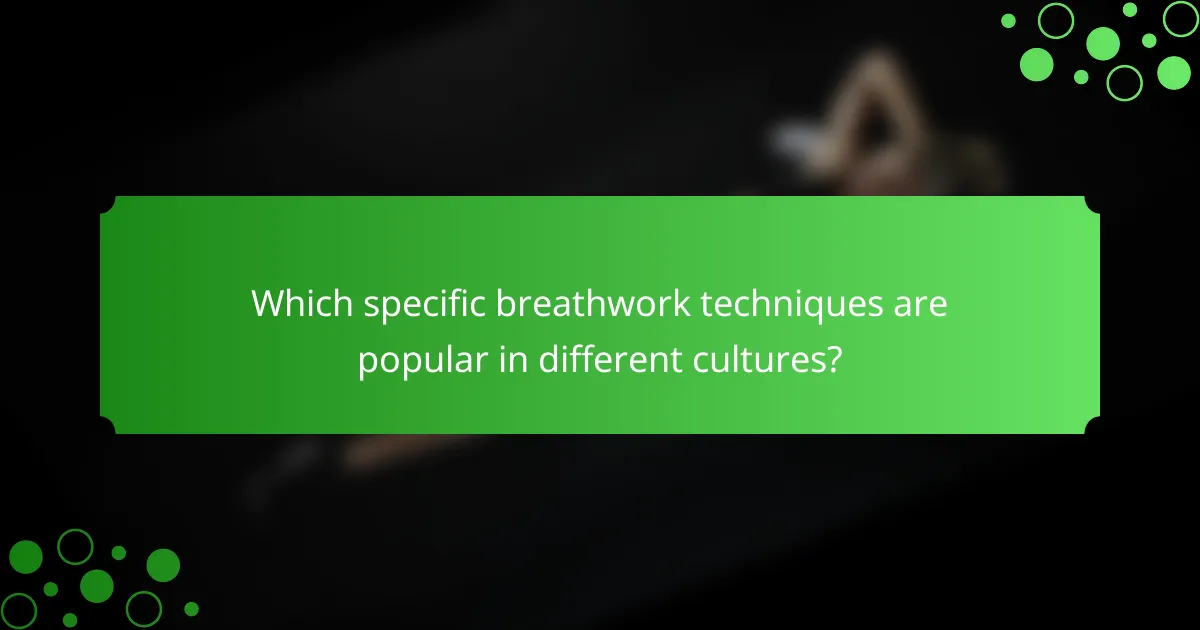
Which specific breathwork techniques are popular in different cultures?
Various cultures utilize distinct breathwork techniques for anxiety relief and emotional release.
In India, pranayama is a foundational practice that regulates breath to enhance mental clarity and emotional stability. The technique involves controlled inhalation and exhalation, promoting relaxation.
Tibetan Buddhism employs a method called “Tsa Lung,” which combines breath control with visualization to release emotional blockages and cultivate inner peace. This approach is unique due to its integration of meditation.
In Japan, “Shikantaza,” a form of Zen meditation, emphasizes natural breathing and mindfulness. This rare technique fosters deep emotional awareness, allowing individuals to confront anxiety without judgment.
Native American cultures often practice “breath of fire,” a rapid, rhythmic breathing technique used in ceremonies to energize and release pent-up emotions. This practice is known for its unique ability to connect individuals with their spiritual essence.
How does the practice of breathwork vary across regions?
Breathwork practices for anxiety relief and emotional release vary significantly across regions. In the West, techniques often emphasize mindfulness and therapeutic applications, such as Holotropic Breathwork. In contrast, Eastern practices, like Pranayama, focus on energy control and spiritual growth.
Cultural context shapes these techniques. For example, in India, breathwork integrates with yoga and meditation, promoting holistic well-being. Meanwhile, in Western countries, breathwork is frequently used in therapeutic settings to address mental health challenges.
Regional accessibility influences practice popularity. Urban areas may offer more workshops and trained instructors, while rural regions might rely on traditional methods passed down through generations.
Overall, the diversity in breathwork reflects cultural values, accessibility, and the unique needs of each community.
What unique attributes do specific breathwork techniques have?
Specific breathwork techniques offer unique attributes that enhance their effectiveness for anxiety relief and emotional release. For instance, the “Box Breathing” technique promotes relaxation through structured inhalation and exhalation patterns, while “Holotropic Breathwork” facilitates deep emotional release by inducing altered states of consciousness. “Diaphragmatic Breathing” strengthens the connection between breath and body awareness, aiding in stress reduction. Each technique’s distinct approach caters to different emotional needs, making them valuable tools in personal wellness practices.
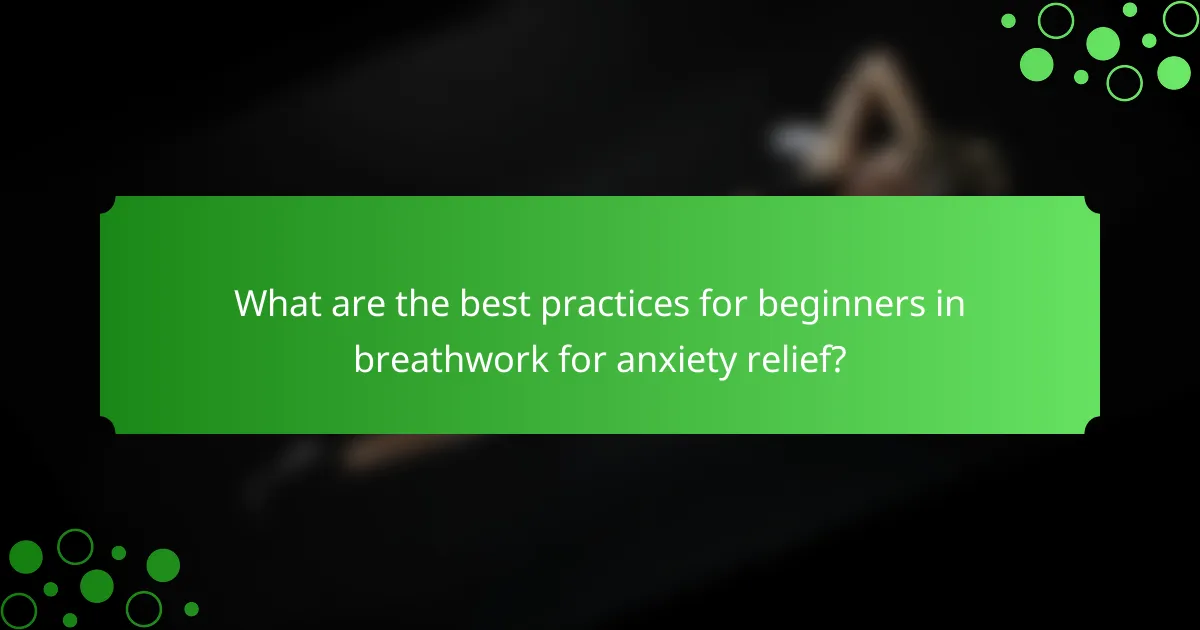
What are the best practices for beginners in breathwork for anxiety relief?
Breathwork techniques for anxiety relief include practices that promote relaxation and emotional release. Beginners should focus on diaphragmatic breathing, box breathing, and alternate nostril breathing.
Diaphragmatic breathing involves inhaling deeply through the nose, allowing the diaphragm to expand, and exhaling slowly through the mouth. This technique enhances oxygen intake and reduces stress levels.
Box breathing consists of inhaling for four counts, holding for four counts, exhaling for four counts, and holding again for four counts. This method stabilizes the nervous system and fosters a sense of calm.
Alternate nostril breathing balances the body’s energies by inhaling through one nostril, holding the breath, and exhaling through the other nostril. This practice can help alleviate anxiety and improve focus.
Consistent practice of these techniques can significantly enhance emotional well-being and resilience against anxiety.
Which common mistakes should beginners avoid when practicing breathwork?
Beginners should avoid rushing, neglecting proper posture, and overthinking their breath patterns. These mistakes can hinder the benefits of breathwork for anxiety relief and emotional release. Focusing on slow, intentional breaths promotes relaxation. It’s essential to create a comfortable environment to enhance the experience.
How can individuals create a personalized breathwork routine for emotional well-being?
Individuals can create a personalized breathwork routine for emotional well-being by identifying their specific needs and preferences. Start by selecting techniques that resonate, such as diaphragmatic breathing or box breathing. Establish a consistent schedule, dedicating time daily or weekly for practice. Incorporate mindfulness by focusing on sensations and emotions during sessions. Track progress and adjust techniques as needed to enhance emotional release and anxiety relief.
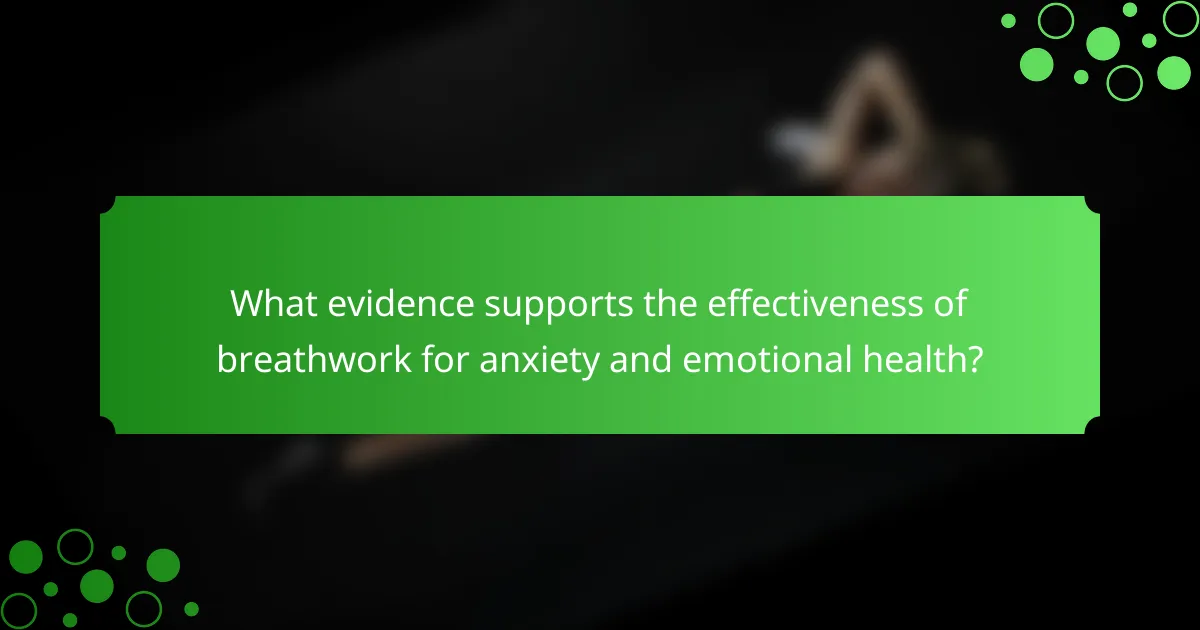
What evidence supports the effectiveness of breathwork for anxiety and emotional health?
Breathwork techniques effectively reduce anxiety and enhance emotional health. Research shows that practices like diaphragmatic breathing and box breathing lower cortisol levels and improve mood. A study published in the Journal of Psychosomatic Research found that participants experienced a significant reduction in anxiety after engaging in breathwork sessions. Additionally, breathwork fosters mindfulness, which is linked to emotional resilience. These techniques empower individuals to manage their emotional responses and promote overall well-being.
Which studies highlight the benefits of breathwork in clinical settings?
Several studies demonstrate the effectiveness of breathwork in clinical settings for anxiety relief and emotional release. Research indicates that breathwork techniques can significantly reduce anxiety symptoms, enhance emotional regulation, and improve overall mental health. For example, a study published in the Journal of Clinical Psychology found that participants who engaged in breathwork experienced a 30% reduction in anxiety levels within just a few sessions. Another study highlighted the role of breathwork in trauma recovery, showing that it helps individuals process emotions and release stored trauma effectively. These findings underscore the therapeutic potential of breathwork as a valuable tool in clinical practice.
How do personal testimonials compare with scientific findings on breathwork?
Personal testimonials often highlight subjective experiences with breathwork, while scientific findings provide measurable outcomes. Testimonials emphasize emotional relief and personal transformation, showcasing individual journeys. In contrast, scientific studies quantify benefits like reduced anxiety levels and physiological changes, offering a broader understanding of breathwork’s effectiveness. Both perspectives are valuable; testimonials inspire and motivate, while scientific evidence lends credibility and supports the practice. Balancing personal narratives with empirical data enhances the overall understanding of breathwork techniques for anxiety relief and emotional release.